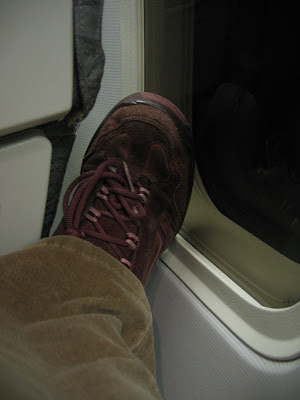 Pies
PiesLa semana pasada Daniel y yo cruzamos el mundo. Los tres tramos que hicimos (Londres-Dubai; Dubai-Brunei; Brunei-Auckland) nos llevaron 36,5 horas. Ahora he hecho ese vuelo unas cuantas veces. Es largo, tiene momentos muy aburridos pero cuando lo haces el viaje es soportable. Pero en este viaje me di cuenta de una cosa. En cada tramo, la persona que estaba en el asiento de detrás de mí se quitó los zapatos.
Quitarse los zapatos es normal y se recomienda en los viajes largos, los pies se hinchan, y a veces doblan su tamaño normal. En pocas palabras, llevar zapatos puede ser muy incómodo. Lo que no es normal, y es de hecho extremadamente maleducado, es no usar los calcetines que aporta la línea aérea y poner tus pies olorosos en el lugar donde la persona que va delante de ti tiene derecho a apoyar el brazo. Soy perfectamente consciente de que mis zapatos favoritos son viejos y uno no querría tener la nariz demasiado cerca de ellos.
Antes de que el avión hubiera iniciado el despegue, en cada tramo, olisqueaba el aire preguntándome de dónde llegaba la peste. Afortunadamente nos dieron montones de mantas y tapaba el hueco con ellas y esperaba hasta acostumbrarme al olor. En el último tramo el tipo que había detrás de mí poseía los pies con peor olor que he tenido el disgusto de encontrar jamás. Afortunadamente el avión estaba medio vacío así que pudimos trasladarnos a un área donde la gente llevaba zapatos o tenía puestos los calcetines de la compañía aérea.
Una nota: si por casualidad estás en un viaje largo, por favor no olvides que otra gente está atrapada en el aire, durante muchas horas y sin escapatoria. Sé educado, coge un par de calcetines limpios y si te quitas los zapatos, mételos junto a los calcetines que has llevado durante horas en una bolsa de plástico y enfunda tus pies en los calcetines limpios que has llevado contigo cuidadosamente.
Feet
Last week Daniel and I crossed the world. The three legs we did (London – Dubai; Dubai – Brunei; Brunei – Auckland) took us 36.5 hours. I have done that flight a few times now. It is long, it has its very boring moments but when you are doing it the traveling is bearable.
But on this trip I found one thing. On every leg of this journey the person in the seat behind me would take off their shoes.
Removal of shoes is normal and recommended on long haul flights, your feet swell up, and sometimes double their normal size, in short wearing shoes can get very uncomfortable. What is not normal, and indeed is extremely impolite is not using the airline socks provided and propping your smelly foot up on the armrest of the person in front of you. I am perfectly aware that my favourite shoes are old and one would probably not want to have ones nose too close to them.
Before the plane had even begun its taxi down the runway, on each leg, I was sniffing the air wondering where the stench was coming from. Luckily we were given lots of blankets so I would stuff the gap with those and wait to become accustomed to the smell. On the last leg the guy behind me had the worst smelling feet I think I have had the displeasure to encounter. Luckily the plane was half empty so we could move to an area where people were either shod or wearing the airline socks.
A note, if you happen to go on a long haul flight, please don’t forget that other people are trapped in mid air with you for hours on end with no escape. Be polite, take a pair of clean socks and if you remove your shoes, put them and the socks you will have been wearing for hours in a plastic bag and enclose your feet in the clean socks you have thoughtfully bought along.
